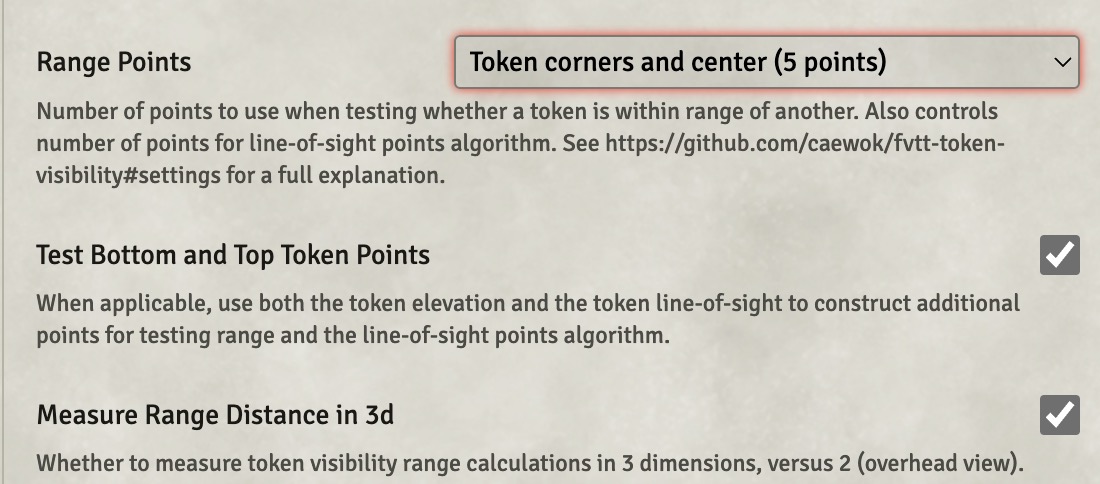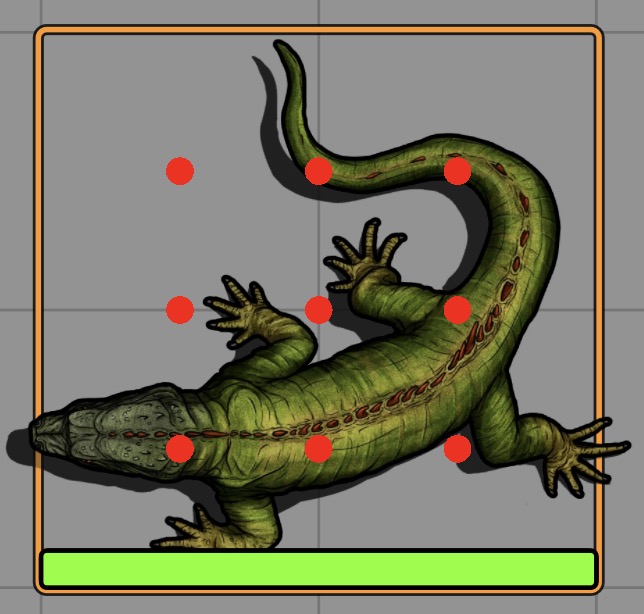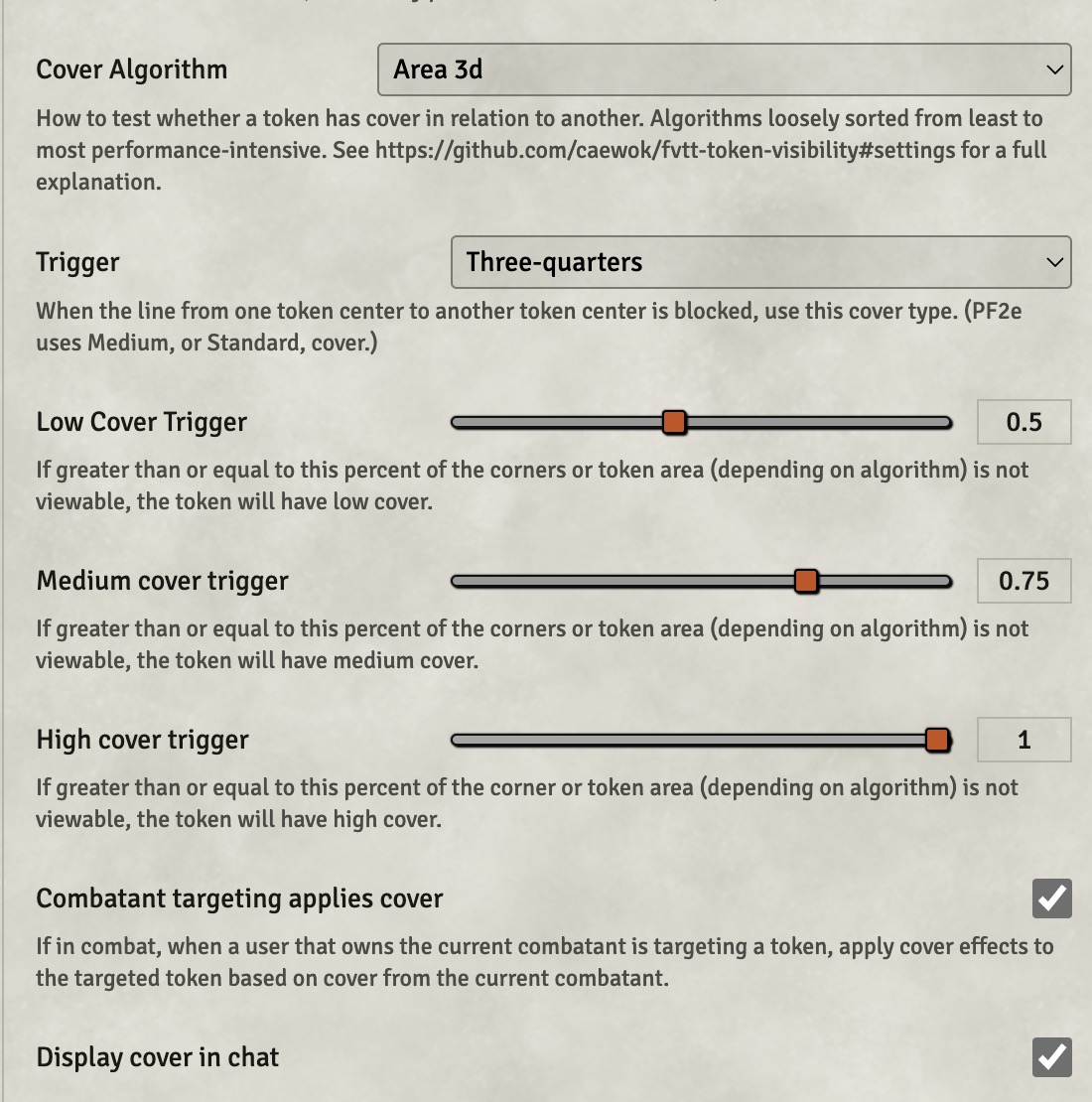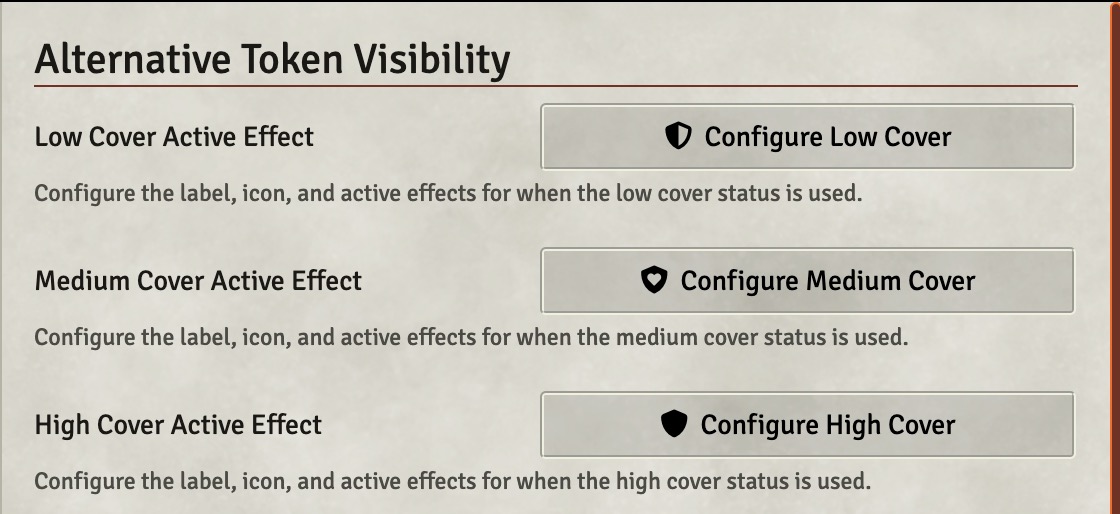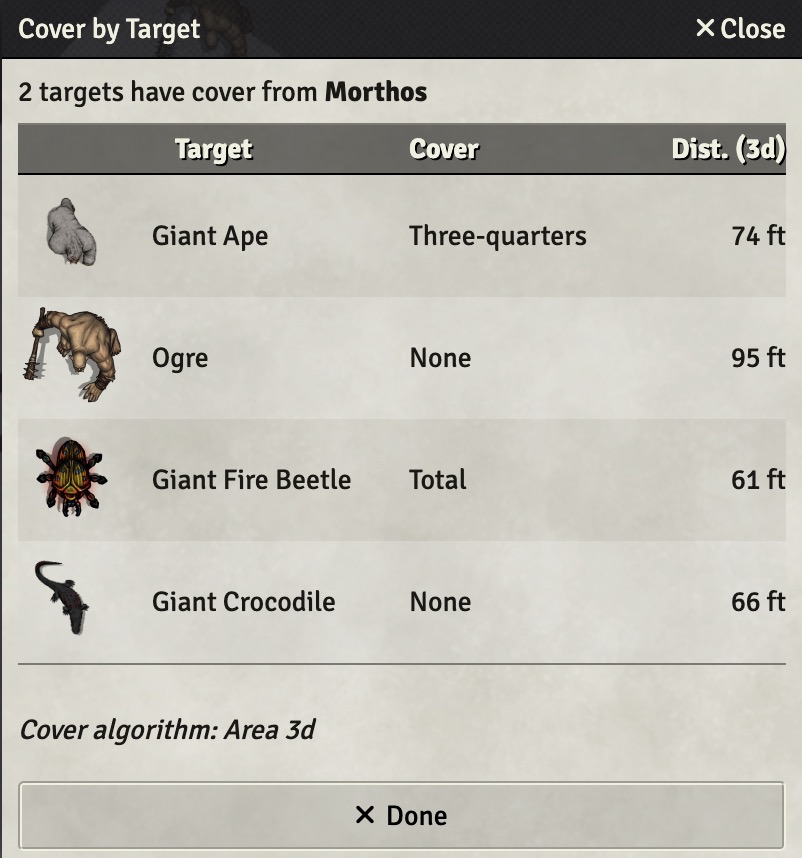This module provides options to modify Foundry's default methods for measuring visibility range and line-of-sight between tokens. Some options are more performant, while others trade some performance for a more precise method of computing visibility.
As of v0.2.0, this module also optionally assists with cover calculations in a (mostly) system-agnostic manner. Various cover measurement options are provided. A macro is also provided to allow any user to calculate cover from one or more selected tokens to one or more targeted tokens. (Import from the Macro compendium.)
Version v0.3.0 introduces the ability to use tokens as cover, and to designate a token with the ability to ignore cover.
By measuring the precise token boundary and by considering intersecting walls, Alt Token Visibility prevents tokens from being seen in situations where they partially overlap a wall. Alt Token Visibility provides additional customizations to control when partially obscured tokens can be seen.
Alt Token Visibility is particularly useful when dealing with token elevations and walls with limited heights or depth, because it focuses on approximating visibility in 3 dimensions.
Add this Manifest URL in Foundry to install.
- Wall Height. Not only does Wall Height provide the ability to set elevation for wall tops and bottoms, it also gives tokens height based on their size. The Area3d option for Alt Token Visibility takes full advantage of token height.
- Elevated Vision. Can assist with setting terrain and token elevations.
- Token Lean. Useful when you want players to be able to "peer" over limited-height walls.
- Midiqol. If midiqol is installed, additional options are presented to allow cover calculations during an attack roll.
Alternative Token Visibility should also work with Perfect Vision and Levels. If either module is installed, measurement of range is left to those modules.
Alt Token Visibility attempts to adjust visibility based on tiles used by Levels, but edge cases may remain. For example, gaps in walls between levels can cause tokens to appear outside unexpectedly. Please feel to file an issue if you see a problem.
- For Points or Area2d algorithms, transparent tile pixels are ignored. This is the same technique Levels uses to create holes.
- For Area3d algorithm, drawings can be used to create holes in tiles. See the Drawing config to set an ellipse, polygon, or rectangle as a hole. FYI, for transparent tiles to work as holes would probably require switching to WebGPU because Area3d relies on polygons and geometry, and does not function at a per-pixel level.
- Range Points: Foundry default (9 points)
- Test Bottom and Top Token Points: unchecked
- Measure Range Distance in 3d: unchecked
- Line of Sight Algorithm: Points on token
- Combatant targeting applies cover: unchecked
- Display cover in chat: unchecked
- Range Points: Token center only (1 point)
Otherwise use the Foundry defaults, above.
Note: Measure Range Distance in 3d has minimal performance impact. Depending on scene walls and token configuration, Area3d can be faster than Area2d.
- Measure Range Distance in 3d: checked
- Test Bottom and Top Token Points: checked
- Line of Sight Algorithm: Token area 3d
- Cover Algorithm: Area 3d
- Cover Algorithm: Corner to corners of select target squares (dnd5e DMG)
- Low Cover Trigger: 0.5
- Medium Cover Trigger: 0.75
- High Cover Trigger: 1
- Combatant targeting applies cover: unchecked
- Display cover in chat: Your choice—--Use this and/or the Measure Cover macro.
- Save as dnd5e cover, with the following changes:
- Confirm that Low, Medium and High Cover Active Effects are to your liking.
- Combatant targeting applies cover: Irrelevant if using Midiqol attack workflow.
- Display cover in chat: Your choice—--Use this and/or the Midi-qol Attack Workflow
- Midi-qol Attack Workflow: Your choice of GM decides, User decides, or Automatically apply
Base Foundry calculates token (and other object) visibility by considering 9 points arranged around the token: the center point plus 8 points spaced out in a rectangular shape.
Range Points lets you change that number:
- Token center ony (1 point)
- Token corners and center (5 points)
- Foundry default (9 points)
Note that the LOS algorithm, "Points on Token," will test the number of points chosen here.
The Wall Height module sets a token height based on the token size. If the token has a height, this option will mirror the points from the bottom of the token to the top of the token, and also add an exact center point. If the token does not have a height, this option is ignored.
If enabled, all range measurements will be in three dimensions. Meaning that, for example, a token flying at 35 feet may be unable to view a target at 0 feet if the token only has 30 feet of darkvision and the scene is dark.
By default, line-of-sight uses the "light" wall restriction when considering whether walls block. This is the same as default Foundry.
Line of Sight Algorithm lets you select from:
- Points on Token. If Range Points is set to 9, this would be the Foundry default.
- Token Area
- Token Area 3d
By default, Foundry measures line-of-sight by drawing a line from the viewer to the 9 points on the target token. If at least one line is not obstructed, then the viewer has line-of-sight to the target.
demo-los-points.mov
Token area works by intersecting the line-of-sight polygon for the viewer token with the 2d shape of the target token (overhead view). In the picture of the token above, this would be the area within the orange border of the token. As walls or wall shadows obscure more of the target token shape, less of its percentage area is viewable.
Note that if the target token is overlapping one or more walls, a "constrained" target shape is first constructed that approximates the portion of the target shape on the same side of the wall(s) as the center point of the target token. This prevents situations where a target token slightly overlapping a wall would otherwise be seen from the "wrong" side of the wall.
demo-los-area2d.mov
Token area 3d constructs a view of the target from the perspective of the viewer token. It is basically equivalent to a first-person shooter view. The walls and the target token shape are then "flattened" in this 2d perspective. The target token area without any walls is compared to one with parts of the target token cut away where walls block.
As with Token Area 2d, the target token is trimmed if walls overlap the target.
This method is probably the most accurate way to determine if a token has visibility of another token, and should, in theory, work even in Ripper's 3d Canvas.
demo-los-area3d.mov
Here is another example with debug drawing on, to illustrate the token's viewing perspective. The token has limited angle vision, as seen by the blue shading, and there are two terrain walls, which cross each other, of different heights. The bright green is where the terrain walls cross and thus block vision. (The light green is only a single terrain wall and would not block vision.) The target in this case is the giant ape, displayed as a red box. The token is above the ground, but not above the giant ape. So it is looking down on the smaller terrain wall in front of it.
For Area 2d and Area 3d, the GM can decide how much of the token must be viewable in order to be "visible." Usually, a low percentage—--say 10% or 20%—--works reasonably well.
The GM can change the percent area required for a token to be visibile, and change how large the token boundary appears for purposes of the visibility test.
Note that the area is calculated as a percentage based on the total area of the token that could be seen. Thus, if a token has an area of 100 but partially overlaps a wall such that 75% of the token rectangle is viewable, then the token only has an area of 75 for purposes of this calculation.
Setting the Percent Token Area to 1 means that the entire token area must be viewable for the token to be seen. Setting the Percent Token Area to 0 means that if any part of the token is viewable, then it is seen.
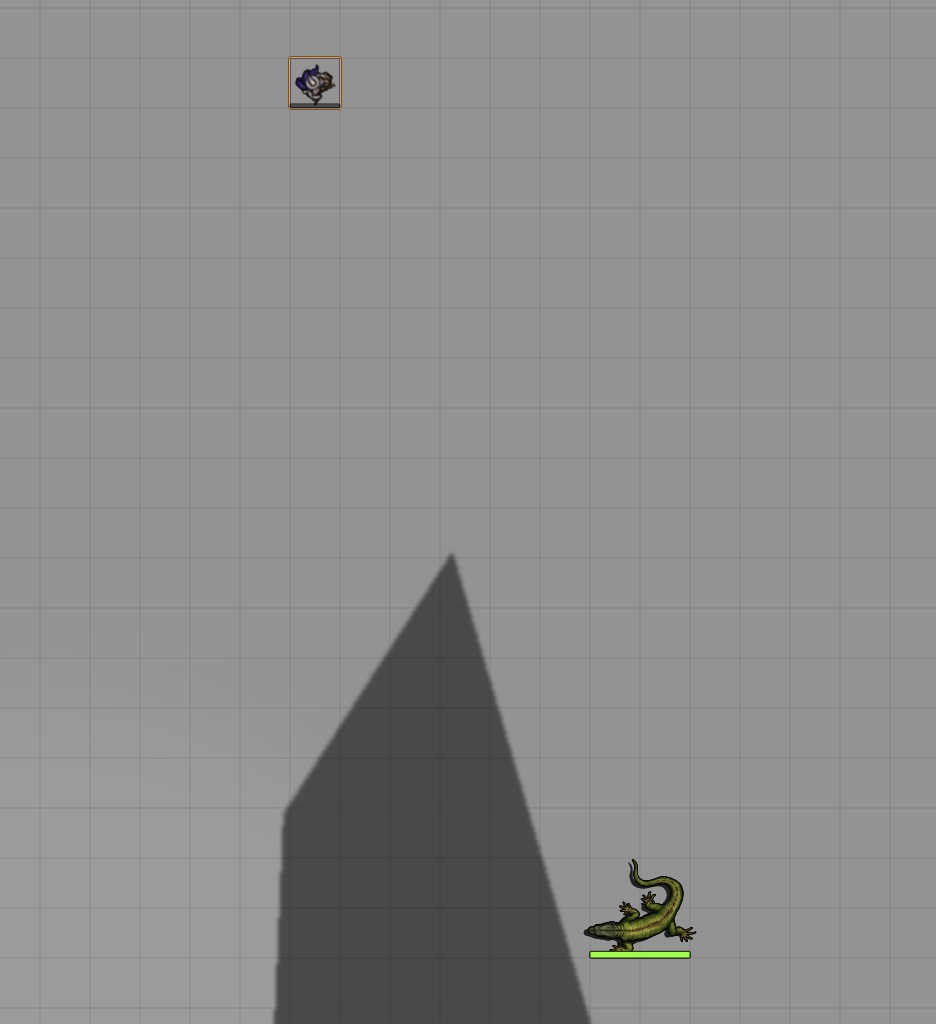 |
|---|
| Area set to 1. Lizard only viewable once our wizard moves completely beyond the wall. |
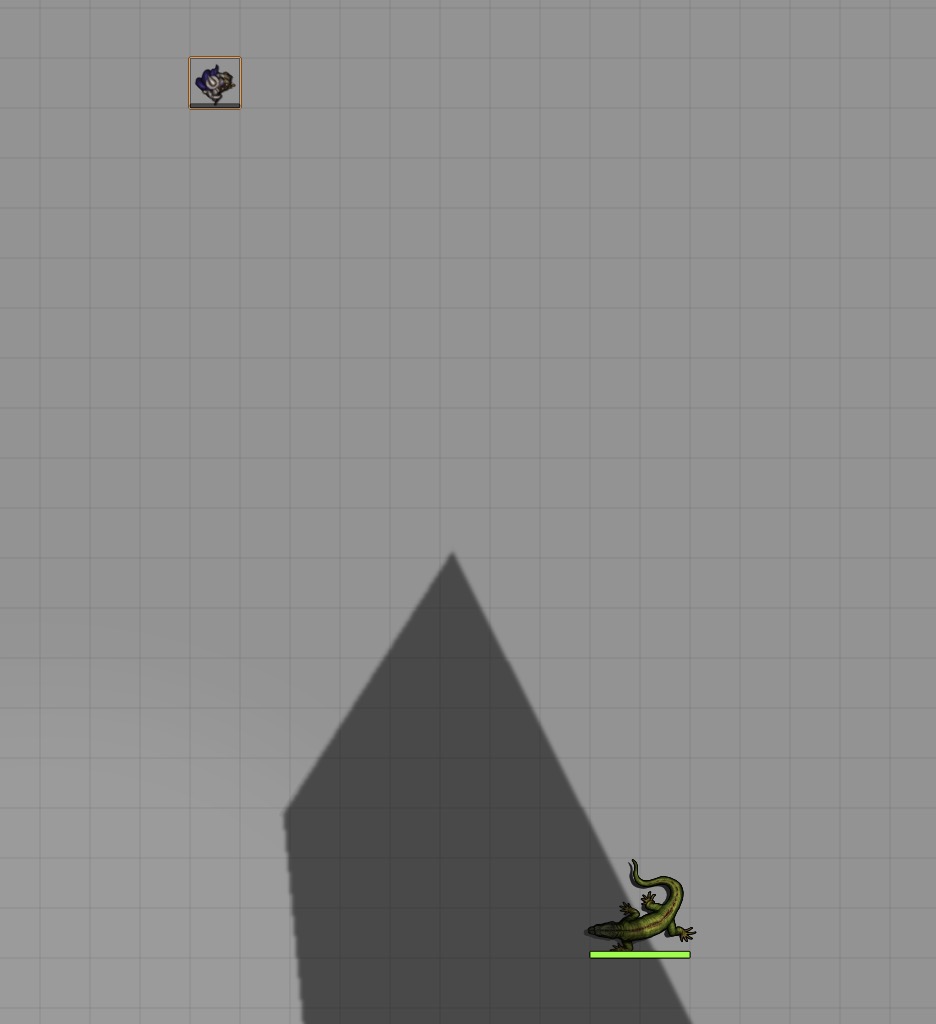 |
|---|
| Area set to 0.5. Lizard viewable once our wizard can view half of it. |
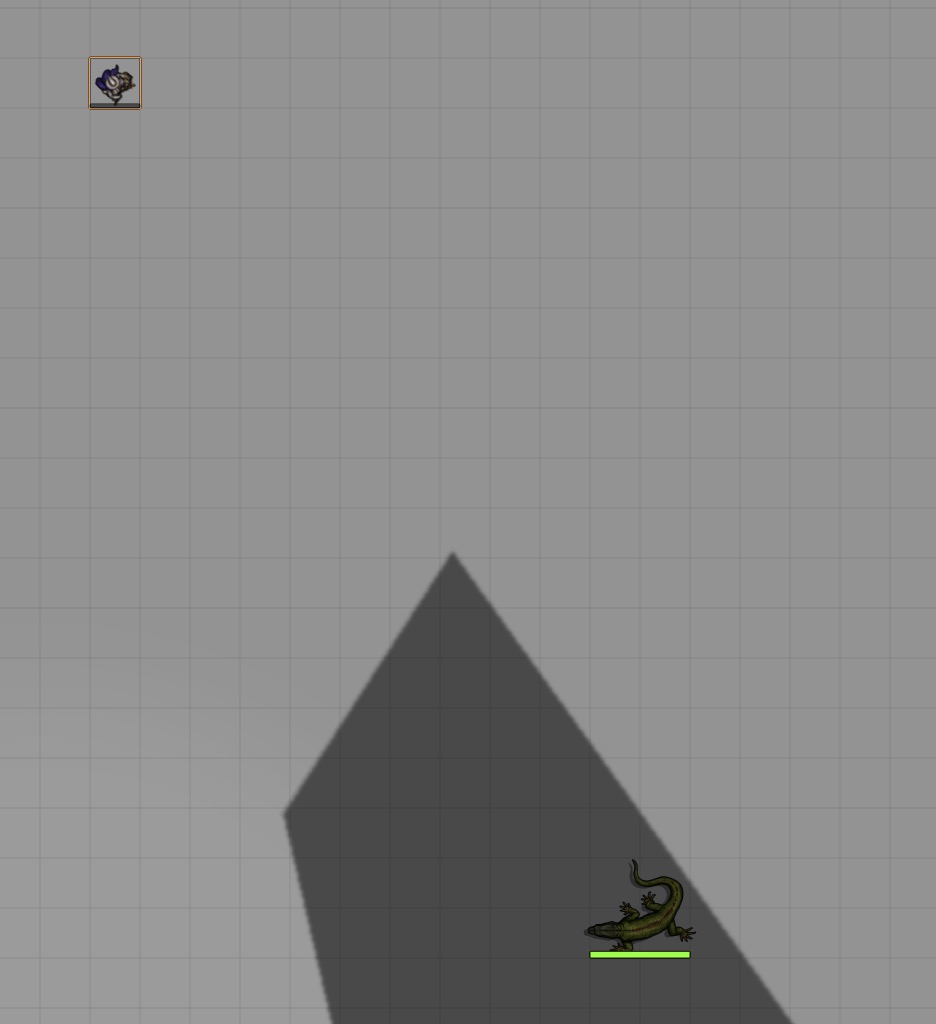 |
|---|
| Area set to 0.1. Lizard viewable when nearly any of it can be seen beyond the wall. |
Cover is abstracted into three distinct levels: low, medium, and high. It is expected that these cover types are ordered, such that as a token becomes less viewable due to a portion of the token being behind an obstacle, the token goes from low --> medium --> high cover.
Settings allow the GM to define the precise limits for cover and the algorithm used. Use the active effet configuration settings to re-name the cover types and apply various active effects.
By default, cover algorithms uses the "move" wall restriction when considering whether walls block. This is intended to be consistent with how walls that would physically block movement are most likely to provide cover. Using the API, it is possible to change this for a given calculation. For example:
api = game.modules.get('tokenvisibility').api;
calc = new api.CoverCalculator(token, target); // token and target are both Tokens you must define.
calc.config.type = "sound" // "move", "light", "sound", "sight"
calc.targetCover()Cover algorithm choices can be split into Points and Area.
Points algorithms draw lines from a point on the viewing token to a point on the targeting token. Either the center or the corner of the viewing token or targeting token can be used. In addition, for larger tokens, an option is available to use only one of the grid squares of the larger token. For this option, the square with the least cover is used.
Area algorithms use the Area 2d or Area 3d algorithms used by LOS, described above.
The following options are provided:
- Viewer center to target center (This is the PF2e default.)
- Viewer center to target corners
- Viewer corners to target corners
- Viewer center to corners of a select target square
- Viewer corners to corners of a select target square (This is the dnd5e DMG method.)
- Area 2d
- Area 3d
The GM can set the "trigger," representing the percent of the token that must not be visible in order to achieve the level of cover.
Center-to-center algorithm: As only one test is done using this algorithm, a single cover type must be selected by the GM.
Points-based algorithms: Percentage of lines blocked for a given grid square/hex test.
Area-based algorithm: Percentage of the token area that is obscured.
The GM can define the name of each cover level, provide an icon, and define active effects for each cover type. Default active effects are provided for dnd5e low (half) and medium (three-quarters) cover. Cover effects can be set as status conditions on a token.
For PF2e, status effects are not added as status conditions. PF2e already has cover effects and the GM is advised to use those.
When enabled, this option applies cover status to targeted tokens during combat. During combat only, if the user that owns the current combatant targets a token, cover is measured and, when applicable, a cover status condition is added to the targeted token.
For dnd5e, enabling this will use the dnd5e attack hook to display cover of targeted tokens in the chat, when an attack is initiated. Targeted tokens without cover are not included in the chat message, and so if no targeted tokens have cover, nothing will be output to chat.
The GM can choose whether dead tokens grant cover and whether to use half the height of the token or the full height. You will need to set the "Token HP Attribute" for your system.
The GM can choose whether live tokens should be considered cover. If the "Token HP Attribute" is not set, all tokens will be considered cover if this is set.
This tells Alternative Token Visibility where to find the HP value for a token in your system. The default for dnd5e is "system.attributes.hp.value." A token with 0 or less HP is considered "dead" for purposes of cover.
If Midiqol is active, the GM can choose whether cover status conditions should be applied to targeted tokens. Statuses are applied after targeting occurs in the midiqol workflow. Options:
- Do not test for cover
- Ask user to confirm.
- Ask GM to confirm.
- Apply automatically
For the confirmation options, this pops up a list of targets with calculated covers. Cover types can then be changed by the user or GM, respectively.
A token can be set to ignore cover less than or equal to some amount. For example, a token set to ignore Medium cover (3/4 cover in DND5e) will also ignore Low cover (1/2 cover in DND5e). Tokens can be set to ignore cover for all attacks (all), or any of the following: melee weapon (mwak), ranged weapon (rwak), melee spell (msak), or ranged spell (rsak).
To set ignoring cover on a specific token, use, for example:
api = game.modules.get('tokenvisibility').api;
cover_type = api.COVER_TYPES;
_token.ignoresCoverType.all = cover_type.LOW;
_token.ignoresCoverType.rwak = cover_type.MEDIUM;
rangedWeaponIgnored = _token.ignoresCoverType.rwak;For linked actors, these values will be set on the actor.
In dnd5e, tokens can also be set to ignore cover for all attacks using the Special Traits token configuration menu.
For Midiqol workflows, the special flags for sharpshooter and spell sniper will be checked when using _token.ignoresCoverType and during the midi workflow if cover checking is enabled in the midiqol attack workflow setting, described above.
A compendium macro, "Measure Cover" is provided to allow users to easily measure cover. Select one or more tokens and target one or more tokens. Cover will be measured for each token --> target combination and the results reported in a pop-up.
A second version of this macro, "Cover Debug Tester" temporarily enables the debug visibility so you can get a better sense of what the cover algorithm is detecting.
If a token is set to ignore cover, that information will be provided in the pop-up display. It is assumed the GM or user will than take that information into account as needed.
Base Foundry calculates token (and other object) visibility by considering 9 points arranged around the token: the center point plus 8 points spaced out in a rectangular shape.
Alt Token Visibility instead considers the whole token shape—the orange outline in the above image.
Depending on settings and scene layout, Alternative Token Visibility may be faster or slower than the default Foundry approach. (The default Foundry approach is already very fast, so the speed improvement, if any, is minimal.) It is usually slower.
Setting area = 0 tends to be a bit faster than other area settings. When area is set to less than or equal to 50%, calculations for visible tokens tend to be faster. When area is set to greater than 50%, calculations for non-visible tokens tend to be faster. When a token partially overlaps a wall, Alt Token Visibility must re-construct the visible shape, which is slow.
Area3d can be faster than Area2d, depending on settings and scene layout.
You can test performance on a given scene by selecting a token on the scene and running the following code in the console. This will test whether the selected token can see every other token in the scene, and will test cover, for a variety of settings.
api = game.modules.get('tokenvisibility').api;
N = 100; // Change if you want more iterations.
api.bench.benchAll(N)Various methods and classes are exposed at game.modules.get('tokenvisibility').api. These may change over time as this module evolves.
Of interest:
- Benchmarking methods, at
api.bench. - Cover calculator class:
api.CoverCalculator. - Class to assist with ignoring cover:
IgnoresCoverClasses: {
IgnoresCover,
IgnoresCoverDND5e,
IgnoresCoverSimbuls
},`Each class has methods to set and return cover types to be ignored for all, mwak, msak, rwak, and rsak. The parent class is IgnoresCover. See IgnoresCoverDND5e for an example extension for system-specific values.
- Area2d and 3d classes:
api.Area2dandapi.Area3d - Debug toggles.
api.debug.range,api.debug.los,api.debug.cover. This will draw various indicators on the screen to help understand what a given algorithm is doing.
Feel free to message me in Discord if you have questions about specific methods.



